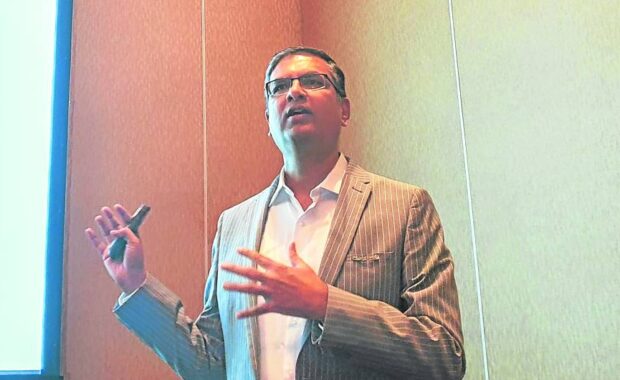
Rajesh Ganesan —TYRONE JASPER PIAD
SINGAPORE—Companies in the Philippines and rest of Southeast Asia must invest in technology-enabling hybrid work setup to retain talents who want more flexibility by allowing tasks to be done remotely, according to information technology (IT) service provider ManageEngine.
Rajesh Ganesan, president of the technology firm, says that employees now prefer working under a hybrid scheme, a trend that emerged during the pandemic when mobility restrictions were heavily curtailed.
“It (hybrid work setup) is not [just] a perk. It is the way moving forward,” he tells the Inquirer in an interview ahead the company’s inaugural User Conference in Southeast Asia.
Hybrid work, the combination of on-site and remote work setup, has given employees opportunity to have more time for themselves as they can fulfill their jobs anywhere.
Ganesan explains this has eliminated the need to commute, which gnaws on employees’ productivity.
“It is starting to happen. People resign from companies that mandate only work from office and move to companies that offer hybrid,” the ManageEngine official explains.
According to a study by American technology company Dell, only 8 percent of Philippine enterprises and organizations have been able to digitally pivot right away amid the rise of hybrid work setup during the pandemic. Still, 55 percent say they are ready to adapt to technological advancements.
“You cannot lose the balance because of the work we do. When a model is available, people should be ready to leverage,” he adds.
Rethinking office setup
Enabling a hybrid work setup requires funding and policy development, the tech expert explains.
For one, he says companies planning to break away from traditional office work must establish “unfettered access” from anywhere to “on-premise systems” such as databases and other applications supporting corporate processes.
“If the company can move their technology infrastructure completely to the cloud, this is the ideal situation. Everything is available all the time,” he points out.
Cloud technology provides users access to storage, files, software and servers via the internet.
In terms of implementation, Ganesan stresses that companies must have hybrid work guidelines to ensure smooth workflow.
He explains that companies should identify which employees can actually work remotely. “The policy should be very clear,” he says.
For example, new employees can benefit from onsite work so they can learn the ropes of their duties with guidance from superiors and colleagues.
Threat of cyberattacks
“People with experience could be more productive at home because they’ll get less interruptions,” Ganesan says.
In addition, he notes that some tasks cannot be just done from home, including those customer-facing jobs and facilities management.
In the advent of hybrid work, however, cyberhackers are given a wider attack surface.
For one, corporate-owned devices like laptops are taken out of the office and the servers—while protected—are accessible online.
Ganesan says business email compromise (BEC) attack is one of the common digital threats targeting enterprises.
BEC is a form of cyberattack whereby hackers send emails embedded with suspicious links to business emails of company employees, hoping to trick them into providing access to the corporate IT system.
Ganesan explains that some of these emails pretend to come from a colleague, increasing the possibility of a successful attack.
According to cybersecurity expert Palo Alto Networks, hackers are meticulously studying the behavior of users via social media so the perpetrators can launch a targeted phishing attack that will potentially disrupt business operations and even lead to financial losses.
Microsoft’s recent cyberthreat intelligence report, meanwhile, says the global technology company has detected and looked into 35 million BEC attempts globally between April 2022 and April 2023. On average, 156,000 BEC attempts are registered daily.
Building defenses
In order to protect enterprises from such attacks, Ganesan says a multipronged approach must be implemented.
First, employees must be educated about the cyberattacks that can target them.
Companies, the ManageEngine official says, must reiterate how clicking on suspicious links can eventually lead to leaking of data, which can be costly to retrieve.
He advises business owners to set up a team that can simulate potential cyberthreats to prepare when an actual one is launched.
Lastly, Ganesan says that enterprises should put up antispam solutions that can block scams sent via emails.
A study by technology company Cisco in March showed that only 27 percent of the companies in the Philippines have the capability to fend off cybersecurity threats despite 85 percent of them expecting a potential attack in the next 12 to 24 months.